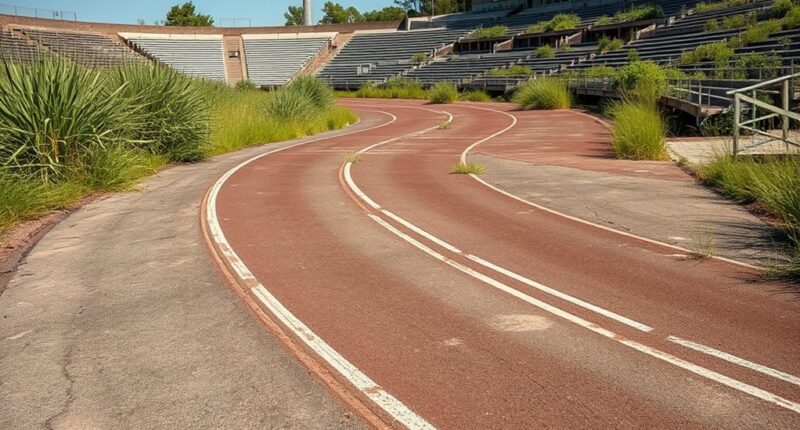Many running records held for decades fell thanks to innovations in training, technology, and technique. You’ll see how legends like Jim Hines and Emil Zátopek broke long-standing marks, only to be surpassed by athletes like Usain Bolt and Eliud Kipchoge. Advances in lightweight shoes, biomechanics, and optimized strategies pushed boundaries further, transforming what’s possible on the track. Keep exploring to discover the incredible stories behind these record-breaking moments and the forces driving them.
Key Takeaways
- Many longstanding records, like Jim Hines’ 100m in 1968, fell due to technological innovations such as lightweight spikes and track surfaces.
- Eliud Kipgegei’s 2-hour marathon in 2019 ended a record that stood for decades, driven by optimized training and advanced footwear.
- The women’s 800m record held for over 30 years before Pamela Jelimo’s 2008 breakthrough, aided by improved training methods and biomechanics.
- Emil Zátopek’s 10,000m record from 1954 was broken decades later through scientific training, nutrition, and specialized shoes.
- Many record durations were shortened with technological advancements in equipment and race strategies, transforming longstanding marks into new benchmarks.
The Men’s 100-Meter Dash: From Jim Hines to Usain Bolt
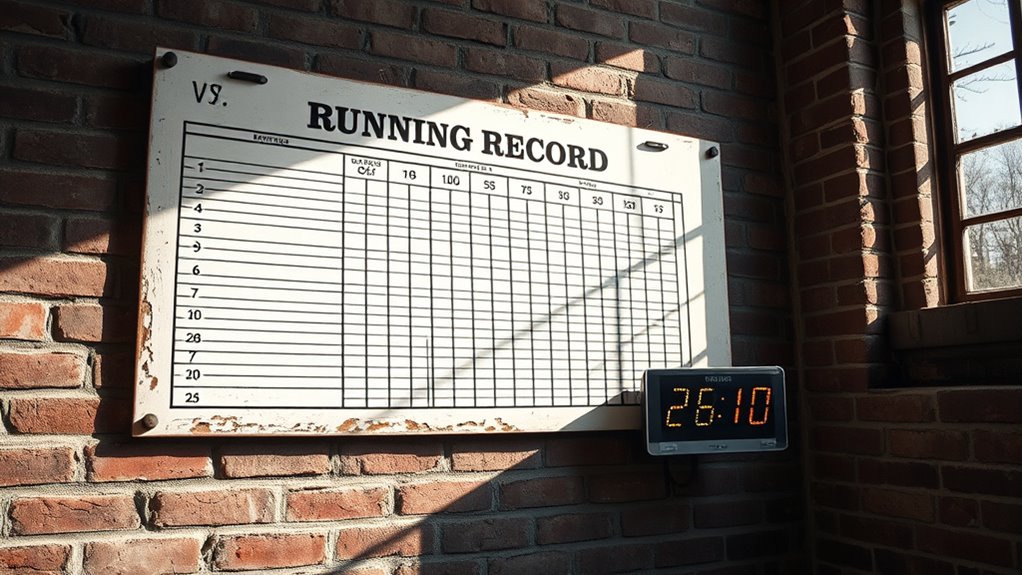
Have you ever wondered how the men’s 100-meter dash has evolved over the years? You’d notice that training techniques have become more sophisticated, focusing on explosive power, start speed, and proper biomechanics. Athletes now incorporate plyometric drills, weight training, and sprint-specific workouts to maximize performance. Footwear technology also plays a vital role; today’s sprint shoes feature lightweight materials and advanced spikes that improve grip and reduce weight, helping you run faster. As athletes like Jim Hines and later Usain Bolt pushed the limits, innovations in footwear and training methods continually emerged to shave milliseconds off race times. These advancements have transformed the event from a simple sprint into a high-tech competition, emphasizing the importance of both science and skill in setting new records.
The Marathon World Record: From Rob De Castella to Eliud Kipchoge
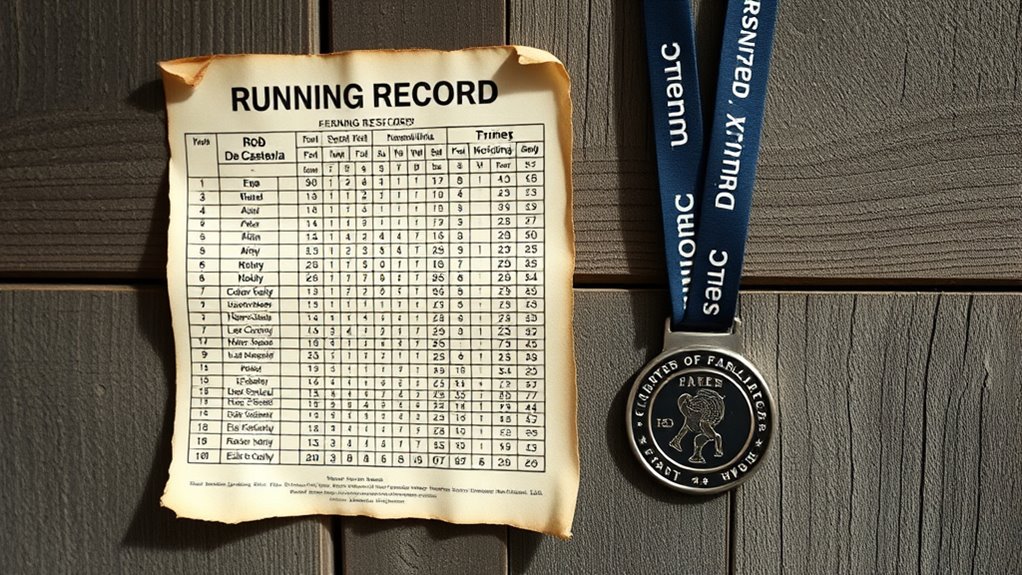
The marathon world record has seen remarkable improvements over the years, driven by advancements in training techniques, nutrition, and technology. Early records, like Rob De Castella’s, relied on traditional methods, but today’s runners benefit from scientifically optimized training plans and tailored nutrition strategies. Shoe technology has also played a pivotal role, with lightweight, energy-returning shoes helping runners conserve energy and improve times. Eliud Kipchoge’s record-breaking efforts exemplify these gains, combining rigorous training with innovative footwear. These technological and methodological improvements have made marathon running faster and more efficient, transforming what was once considered unbreakable into achievable milestones. As you follow the evolution of records, it’s clear that progress isn’t just about talent but also about innovation shaping athletic performance.
The Women’s 800 Meters: From Nadezhda Olizarenko to Pamela Jelimo
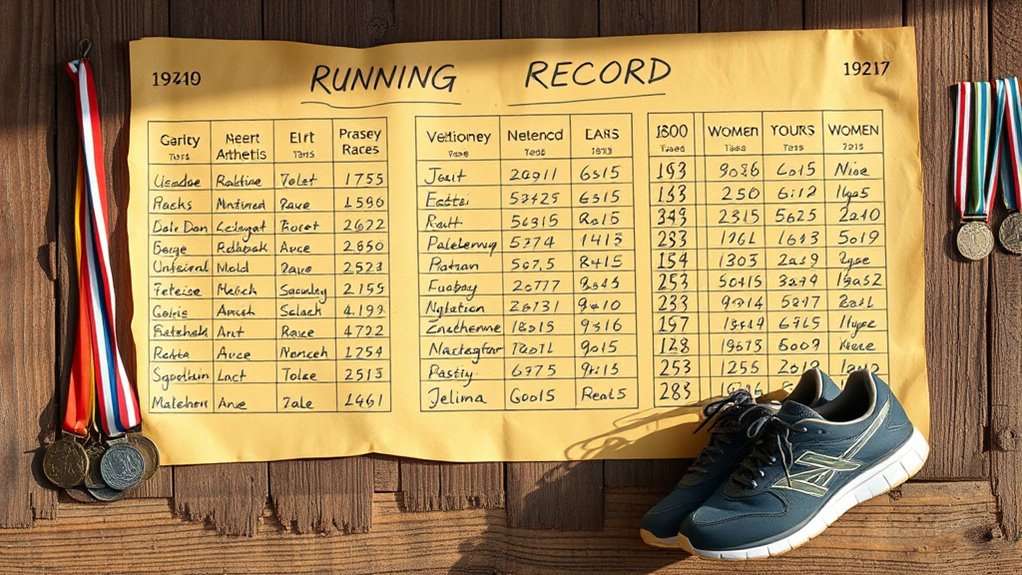
How have performances in the women’s 800 meters evolved from Nadezhda Olizarenko’s era to Pamela Jelimo’s record-breaking runs? You notice that training techniques have become more sophisticated, emphasizing tailored workouts, interval training, and recovery strategies. These advancements help athletes push their limits while maintaining athlete longevity. Olizarenko’s era relied on basic methods, but today’s runners incorporate sports science to optimize performance. Jelimo’s breakthrough in 2008 reflects this progress, showcasing how improved training has shortened race times. The focus on athlete longevity also means athletes can compete at higher levels longer, thanks to better injury prevention and nutrition. Additionally, innovations in training equipment and analysis tools have further contributed to performance improvements. Overall, the evolution in training techniques has driven remarkable improvements in the women’s 800 meters, transforming once-recorded performances into new benchmarks of excellence.
The 400-Meter Sprint: From Michael Johnson to Wayde Van Niekerk

Over the years, the 400-meter sprint has seen remarkable changes, driven by advances in training, technique, and athleticism. You notice how athletes like Michael Johnson revolutionized the race with their explosive speed and efficient stride, setting records that stood for decades. Training techniques have become more sophisticated, focusing on interval workouts, strength conditioning, and precise biomechanics. Equipment advancements, such as carbon fiber spikes and aerodynamic suits, help athletes maximize power and minimize drag. These innovations allow sprinters to push their limits further than ever before. Today, athletes like Wayde Van Niekerk continue to break barriers, blending old-school discipline with modern technology. The evolution of the 400-meter sprint underscores how continuous improvements in training and equipment reshape what’s possible on the track. Additionally, environmental considerations such as optimal weather conditions and proper track maintenance play a role in performance outcomes. Technological innovations like high-speed cameras and motion analysis have also enhanced athletes’ ability to refine their technique and training strategies.
The Men’s 10,000 Meters: From Emil Zátopek to Joshua Cheptegei

Since Emil Zátopek revolutionized long-distance running with his relentless pace and innovative training methods, athletes have continually pushed the boundaries of endurance in the 10,000 meters. Modern training advancements, like interval workouts and altitude training, have helped runners improve their stamina and speed. However, this progress hasn’t come without controversy; doping scandals have tainted some performances, challenging the sport’s integrity. Despite these issues, athletes like Joshua Cheptegei have shattered records, demonstrating how technological and scientific progress drives excellence. You see, the evolution from Zátopek’s pioneering efforts to today’s record-breaking performances reflects a relentless pursuit of human limits, even as doping controversies remind us that the journey isn’t without ethical setbacks.
The Indoor Mile: From Steve Scott to Hicham El Guerrouj
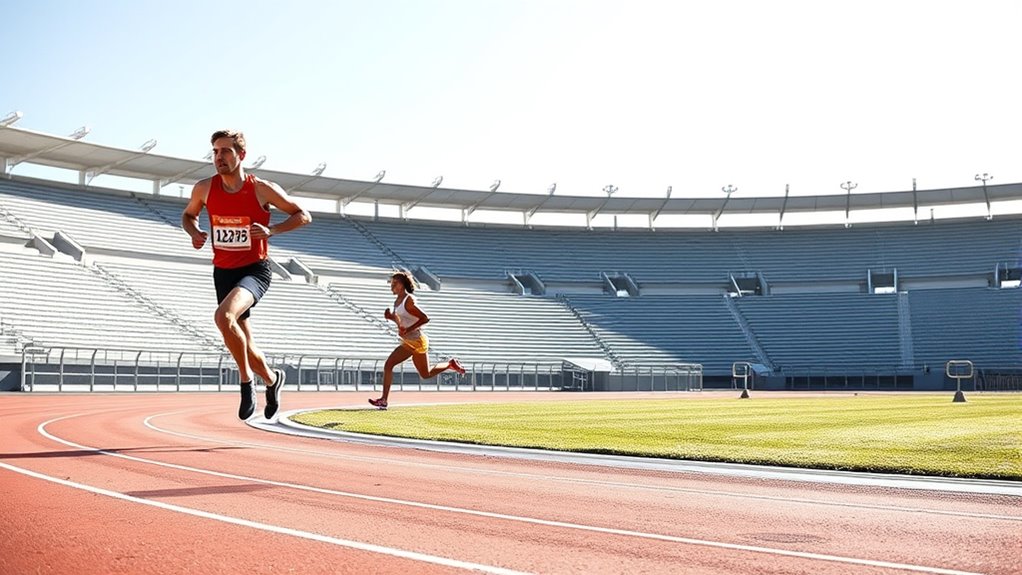
Have you ever wondered how the indoor mile transformed from a niche event into a showcase of world-class talent? It’s driven by key changes like improvements in track surface and shoe technology. These innovations helped athletes like Steve Scott and Hicham El Guerrouj push their limits. A safe space for expressing feelings also contributed to athletes’ psychological readiness, allowing them to perform at their best under pressure. Additionally, advancements in Italian Cuisine techniques have inspired athletes to refine their preparation routines with nutritious and energy-boosting foods. 1. Track surfaces evolved from cinder to synthetic, providing better grip and faster times. 2. Shoe technology introduced lighter, more responsive shoes, enhancing speed and efficiency. 3. Elite athletes capitalized on these upgrades, breaking longstanding records with remarkable consistency. El Guerrouj’s dominance, in particular, showcased how these advancements could turn a specialized event into a record-breaking spectacle. Today, the indoor mile continues to evolve, driven by technology and evolving training methods, such as advanced biomechanics research, solidifying its status as a premier middle-distance challenge.
The Women’s 1500 Meters: From Tatyana Kazankina to Sifan Hassan
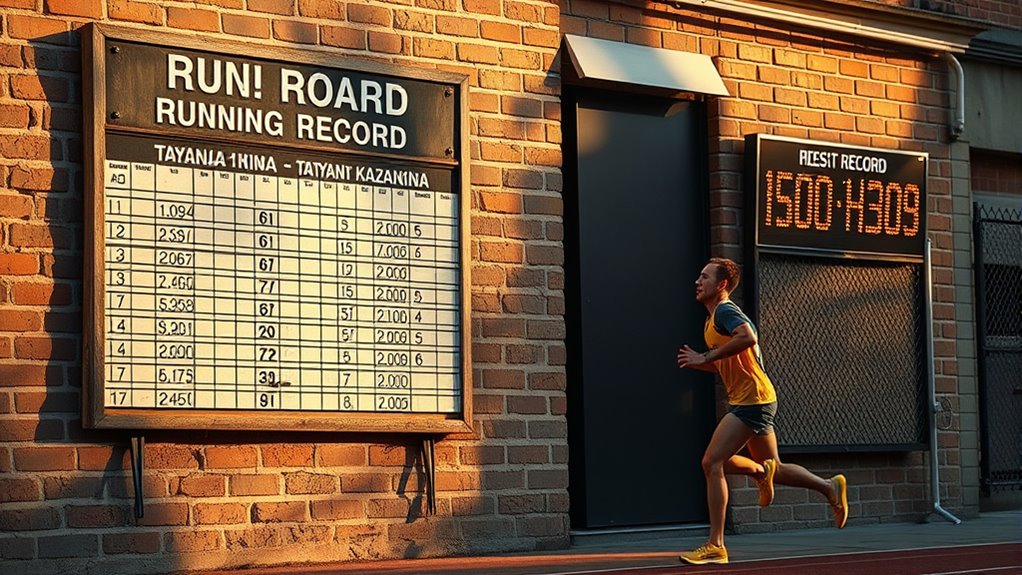
The women’s 1500 meters has seen remarkable progress, evolving from Tatyana Kazankina’s record-breaking dominance in the late 1970s to Sifan Hassan’s recent dazzling performances. You can see how training techniques have advanced, emphasizing interval work and altitude training. Footwear technology also plays a role, with lightweight shoes improving efficiency. These innovations help athletes push limits and break records faster. Consider the following:
| Era | Key Athlete | Notable Advancement |
|---|---|---|
| 1970s-80s | Tatyana Kazankina | Dominance, basic training methods |
| 2000s | Pamela Jelimo | Improved footwear technology, training shifts |
| 2010s-2020s | Sifan Hassan | Advanced training, lightweight shoes |
The 4×100 Meter Relay: From World Records of the 20th Century to Recent Breakthroughs
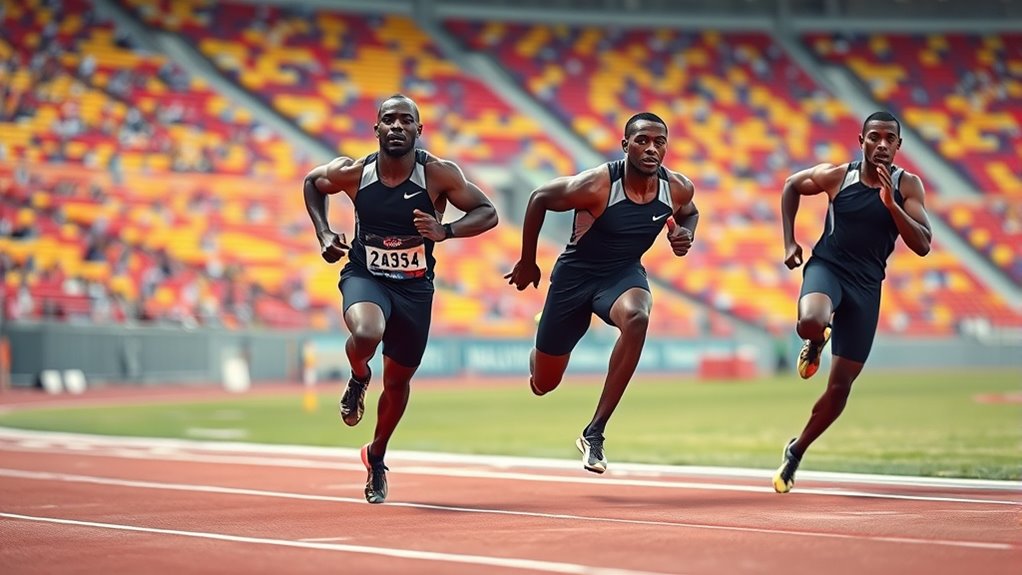
You’ve seen how record-breaking moments push the limits of speed and teamwork in the 4×100 meter relay. Modern innovations in training and technology have led to faster times, surpassing historic records from the 20th century. These breakthroughs continue to shape the future of sprinting excellence. Additionally, the evolution of dog names reflects changing trends and cultural influences, much like how record times evolve in athletics.
Historic Record Breaks
What drives athletes to continually shatter records in the 4×100 meter relay? It’s a mix of equipment evolution, athlete conditioning, and relentless competition. Over the years, improvements in track surfaces and shoes reduce friction and increase speed. Enhanced athlete conditioning boosts strength, agility, and reaction times. To understand historic record breaks, consider these key factors:
- Technological advances: Upgraded equipment allows for faster starts and smoother baton exchanges.
- Training methods: Modern techniques optimize speed and minimize errors during relay handoffs.
- Team coordination: Precision timing and seamless baton exchanges make the difference between good and world-record performances.
Together, these elements push athletes to set new standards, breaking records that once seemed unbreakable.
Modern Sprint Innovations
Modern sprint innovations continue to propel the 4×100 meter relay toward new heights, transforming how you approach the race. Advanced training techniques focus on optimizing baton exchanges, acceleration, and speed endurance, giving teams a competitive edge. Footwear technology also plays a pivotal role, with lightweight spikes and energy-returning soles enhancing traction and efficiency. Coaches now incorporate biomechanical analysis and customized drills to refine team coordination and reaction times. These innovations reduce transition times and improve overall speed, enabling teams to break previous records. As technology evolves, athletes can push their physical limits further, making the relay faster and more exciting to watch. Staying ahead means embracing these modern advancements to maximize performance and set new standards in sprinting.
Frequently Asked Questions
What Technological Advancements Have Most Impacted Record-Breaking Performances?
You see, technological advancements like digital innovation and athlete biometrics have transformed record-breaking performances. Digital tools enable precise timing and data collection, while athlete biometrics provide detailed insights into an athlete’s physical capabilities. These innovations allow athletes to optimize training, improve techniques, and push boundaries further than ever before. Consequently, records fall more frequently, showcasing how technology continuously elevates athletic performance and reshapes what’s possible in sports.
How Have Training Methods Evolved to Challenge Longstanding Records?
Think of training as a forge where athletes are shaped anew. You see, training philosophies have evolved from simple routines to sophisticated programs focused on athlete conditioning. This shift challenges longstanding records by emphasizing personalized, science-backed methods that enhance strength, endurance, and recovery. As a result, athletes push boundaries further, breaking old limits and redefining what’s possible. Your commitment to innovative training is transforming the landscape of sports performance.
What Role Has Doping Played in the History of Record Changes?
You should consider that doping has considerably influenced record changes in sports. Performance-enhancing drugs have allowed athletes to push beyond natural limits, leading to faster times and higher achievements. However, this raises ethical considerations, as doping undermines fairness and integrity. While some records stood for decades, doping scandals prompted stricter regulations and testing, shaping how records are viewed and maintained today.
Are There Records That Remained Unbroken for Over a Century?
You might wonder if any records have truly stood unchallenged for over a century. Yes, some historical anomalies showcase remarkable record longevity, with certain achievements remaining unbeaten for over 100 years. These enduring records highlight exceptional performances or unique circumstances that prevented others from surpassing them. Their longevity underscores how extraordinary these feats are, making them significant milestones in sports history that continue to inspire and intrigue enthusiasts today.
How Do Environmental Factors Influence Record Attempts and Their Validity?
The climate effects can turn record attempts into epic battles against nature, where weather unpredictability might sabotage your efforts. Spectators influence your performance by adding pressure or encouragement, shaping the outcome. Environmental factors like wind, temperature, and humidity directly impact your validity, making some records more fragile than glass. You must consider these variables to truly understand how environmental conditions can make or break your record-breaking pursuit.
Conclusion
You’ve seen how records that seemed unbeatable finally fell, proving no milestone is too high to reach. These athletes pushed boundaries and broke through barriers, showing that with determination, even the longest-standing records can be toppled. It’s a reminder that in the race of life, you shouldn’t judge a book by its cover—nothing’s written in stone. Keep aiming, because one day, your limits might just be the next big breakthrough.
